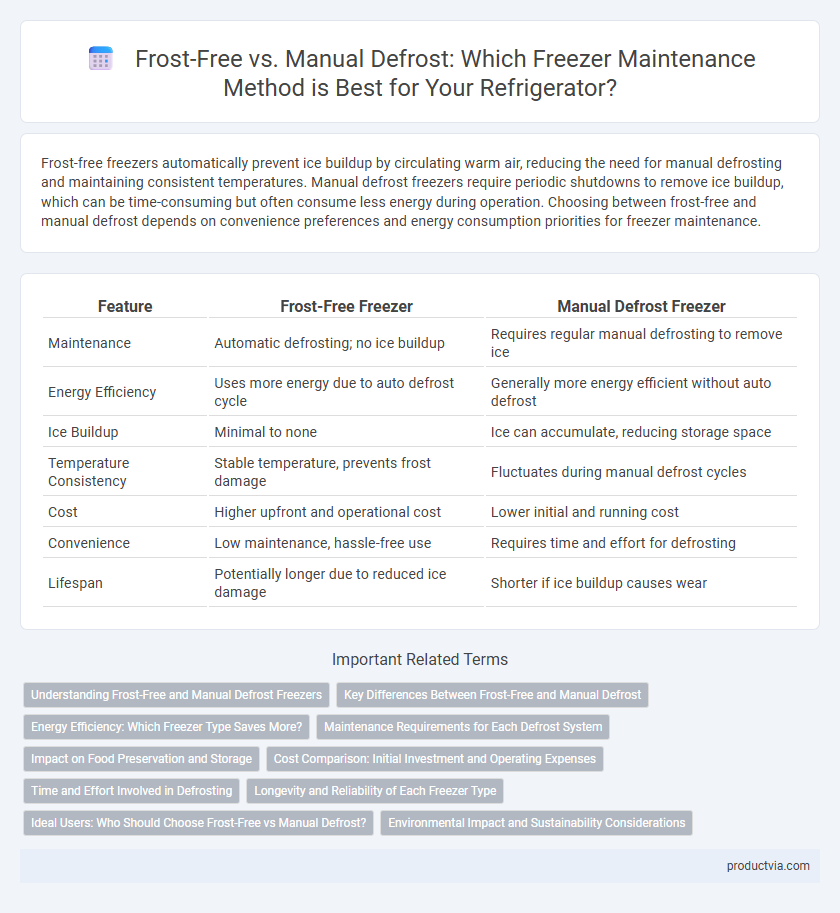Frost-free freezers automatically prevent ice buildup by circulating warm air, reducing the need for manual defrosting and maintaining consistent temperatures. Manual defrost freezers require periodic shutdowns to remove ice buildup, which can be time-consuming but often consume less energy during operation. Choosing between frost-free and manual defrost depends on convenience preferences and energy consumption priorities for freezer maintenance.
Table of Comparison
| Feature | Frost-Free Freezer | Manual Defrost Freezer |
|---|---|---|
| Maintenance | Automatic defrosting; no ice buildup | Requires regular manual defrosting to remove ice |
| Energy Efficiency | Uses more energy due to auto defrost cycle | Generally more energy efficient without auto defrost |
| Ice Buildup | Minimal to none | Ice can accumulate, reducing storage space |
| Temperature Consistency | Stable temperature, prevents frost damage | Fluctuates during manual defrost cycles |
| Cost | Higher upfront and operational cost | Lower initial and running cost |
| Convenience | Low maintenance, hassle-free use | Requires time and effort for defrosting |
| Lifespan | Potentially longer due to reduced ice damage | Shorter if ice buildup causes wear |
Understanding Frost-Free and Manual Defrost Freezers
Frost-free freezers use an automatic defrosting system that prevents ice buildup by periodically warming the evaporator coils, ensuring consistent temperature and minimal maintenance. Manual defrost freezers require users to turn off the unit and remove accumulated ice manually to maintain cooling efficiency and prevent damage. Understanding these differences helps in selecting a freezer based on convenience, energy consumption, and maintenance preferences.
Key Differences Between Frost-Free and Manual Defrost
Frost-free freezers use an automatic heating element to prevent ice buildup, eliminating the need for manual defrosting and maintaining consistent temperature levels. Manual defrost freezers require periodic thawing to remove ice, which can lead to temperature fluctuations and higher energy consumption during defrost cycles. The frost-free model offers convenience and energy efficiency, while manual defrost units are typically more affordable and consume less power when not defrosting.
Energy Efficiency: Which Freezer Type Saves More?
Frost-free freezers use an automatic defrost cycle that eliminates ice build-up, maintaining consistent cooling efficiency and reducing energy consumption over time compared to manual defrost models. Manual defrost freezers require periodic defrosting to prevent ice accumulation, which can insulate cooling elements and increase energy use if neglected. Studies show frost-free freezers typically save 10-15% more energy by maintaining optimal airflow and temperature stability without user intervention.
Maintenance Requirements for Each Defrost System
Frost-free freezers require minimal maintenance due to their automatic defrost cycles that prevent ice buildup, reducing the need for manual intervention. Manual defrost freezers demand regular manual ice removal to maintain efficiency and avoid excessive frost accumulation, which can hinder cooling performance. Proper maintenance of manual defrost systems includes scheduled defrosting and thorough cleaning to ensure optimal freezer operation and energy efficiency.
Impact on Food Preservation and Storage
Frost-free freezers maintain consistent temperatures by automatically eliminating ice buildup, preventing freezer burn and extending the shelf life of stored food. Manual defrost freezers require periodic thawing, which can cause temperature fluctuations that increase the risk of spoilage and reduce food quality over time. Choosing frost-free models supports better food preservation and more efficient storage management by minimizing ice accumulation and maintaining stable freezing conditions.
Cost Comparison: Initial Investment and Operating Expenses
Frost-free freezers typically have a higher initial investment due to advanced components like fans and heaters, increasing upfront costs compared to manual defrost models. Operating expenses for frost-free units rise with continuous energy use to prevent ice buildup, while manual defrost freezers consume less power but require labor-intensive defrosting to maintain efficiency. Over time, manual defrost freezers often prove more cost-effective for budget-conscious users, whereas frost-free models offer convenience at the expense of higher electricity bills.
Time and Effort Involved in Defrosting
Frost-free freezers eliminate the need for manual defrosting by utilizing an automatic defrost cycle, saving significant time and effort in freezer maintenance. Manual defrost freezers require periodic defrosting to remove ice buildup, which can be time-consuming and labor-intensive, often taking several hours. Choosing a frost-free model reduces maintenance frequency and provides consistent cooling efficiency, enhancing user convenience.
Longevity and Reliability of Each Freezer Type
Frost-free freezers offer enhanced reliability by automatically preventing ice buildup, which reduces maintenance frequency and prolongs the appliance's operational lifespan. Manual defrost freezers, though requiring regular defrosting to maintain efficiency, often have fewer mechanical components, potentially resulting in longer durability under proper care. Choosing between frost-free and manual defrost directly impacts freezer longevity, as frost accumulation affects compressor performance and energy consumption.
Ideal Users: Who Should Choose Frost-Free vs Manual Defrost?
Frost-free freezers are ideal for busy households or users seeking low-maintenance appliances, as they automatically prevent ice buildup and maintain consistent cooling without manual intervention. Manual defrost freezers suit those who prefer energy-efficient models and don't mind periodically defrosting to remove ice buildup, often resulting in lower upfront costs and increased reliability. Users prioritizing convenience and consistent performance typically choose frost-free models, while budget-conscious and minimalist users may opt for manual defrost freezers.
Environmental Impact and Sustainability Considerations
Frost-free freezers use automatic defrost cycles that consume more energy but reduce the need for manual maintenance and prevent ice buildup, enhancing operational efficiency. Manual defrost freezers, while less energy-intensive during use, require periodic defrosting that can increase energy consumption temporarily and contribute to food waste if not managed properly. Choosing a freezer with an Energy Star rating and eco-friendly refrigerants improves sustainability by minimizing greenhouse gas emissions and reducing overall environmental impact.
Frost-free vs manual defrost for freezer maintenance Infographic

 productvia.com
productvia.com